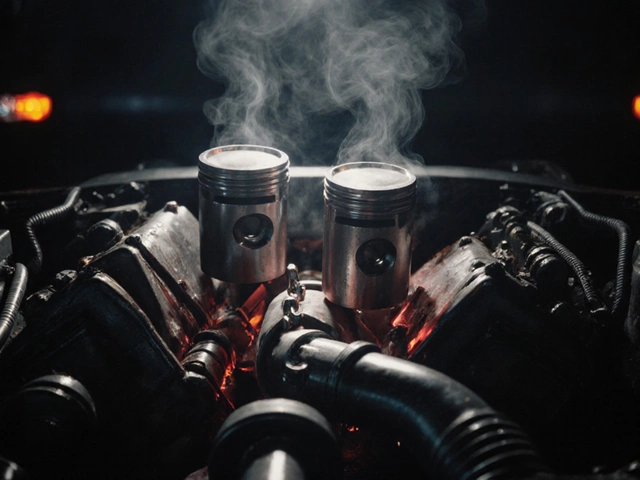Spark plugs may be small, but they’re vital to your vehicle's performance, igniting the fuel that powers your engine. Over time, these components wear out, and knowing when they need replacing can save you from headaches down the road. Ignoring worn spark plugs might lead to inefficient fuel use, engine misfires, and even engine damage.
This article guides you through the subtle and more obvious signs that your spark plugs are past their prime. You'll learn about their key functions, how to check their condition, and tips on selecting the right replacements. Maintaining your spark plugs ensures your vehicle remains reliable, efficient, and ready for whatever journey lies ahead.
- Understanding Spark Plugs
- Signs of Worn-Out Spark Plugs
- Impact on Engine Performance
- How to Check Spark Plugs
- Choosing the Right Spark Plugs
- Tips for Longer Spark Plug Life
Understanding Spark Plugs
Spark plugs might seem like minor components in the grand scheme of your car’s complex systems, but they play an enormous role in ensuring a vehicle operates smoothly. Without a properly functioning spark plug, your car's engine would be unable to start at all. Found at the top of each cylinder, spark plugs create electric sparks that ignite the fuel-air mixture needed for combustion. This process sets off a chain reaction that powers your vehicle, translating the energy from combustion into mechanical motion. This makes performance without effective spark plugs impossible.
Designed to withstand the extreme pressures and temperatures within an engine, spark plugs are built from durable metal and ceramic materials. Despite this robust construction, they endure significant wear and tear over time. Their electrodes slowly erode, reducing the plug’s ability to generate sparks and ignite the fuel-air mix effectively. Generally, a standard spark plug lasts between 20,000 and 30,000 miles, though some advanced versions might exceed this range, reaching up to 100,000 miles. Added strain such as stop-and-go traffic, frequent short journeys, or an aging engine can all contribute to quicker wear. It's important for car maintenance that vehicle owners understand these dynamics to keep their engines healthy.
"The reliable performance and efficiency of an engine largely depends on the spark plugs," notes John Bobo, a renowned automotive expert. "Most drivers underestimate the importance of regularly checking and replacing them, risking unwanted breakdowns and costly repairs."
A spark plug consists of several parts: electrodes, insulators, and the shell. Each component is vital in creating the necessary conditions for ignition. The center electrode is threaded into the engine head to provide grounding. An insulator around the electrode prevents electrical shorts, ensuring effective operation. Finally, the shell serves as a protective layer against external contaminants like oil and carbon deposits. This meticulous construction is why spark plugs are such reliable components, albeit ones that require periodic checking. Pay attention to these details, as recognizing the signs of deterioration will help preserve both your engine performance and your bank account, ultimately keeping your car in prime condition.
Signs of Worn-Out Spark Plugs
Recognizing when your spark plugs need replacing isn't as mysterious as one might think, yet many car owners overlook the early signals. One telltale sign is a noticeable drop in fuel economy. When spark plugs are worn, they might struggle to ignite the fuel efficiently, leading to wasted fuel. This can hit you at the pump quite hard, as your car demands more fuel to compensate for inefficient combustion. If you notice that your regular trips are costing you more, it could be the spark plugs whispering for attention. Another common indicator is a rough idle. When your engine is running but the car is stationary, listen for a stable, consistent hum. Worn-out spark plugs might cause shaking, vibrations, or irregular revving, which shouldn’t be ignored.
Pay attention to your vehicle's acceleration. If your car hesitates or takes longer to get up to speed when you press the gas pedal, it might be due to faulty spark plugs. This hesitation can often be mistaken for other engine problems, but it's a clear pointer that spark plugs are struggling to do their job effectively. They might not be producing the strong sparks needed to ignite the engine’s air-fuel mixture promptly. Engine misfires are another dead giveaway. If the engine stumbles when you try to accelerate or you hear intermittent sputtering, it’s possibly because of spark plug issues. Misfires can lead to heightened emissions, which eventually fail you at an emissions inspection, and no one wants that surprise.
For those with a more attuned ear, unusual engine sounds can also be a sign. Clicking, knocking, or pinging noises could stem from excessively worn spark plugs firing inconsistently. Additionally, if your car produces starting problems, especially on cold mornings, it might be the spark plugs failing to fire up the engine reliably. This is particularly common in older models that don’t have advanced ignition systems. A consistent surge in engine performance — where the vehicle lurches forward unexpectedly — could also point to spark plug issues. This occurs when residual fuel ignites due to spark inconsistency.
Visual Inspection
A simple visual inspection can be telling. If you're familiar with what they look like, take them out and inspect the electrodes. Signs like dark deposits, carbon fouling, or wear can indicate they are due for a change. According to experts, “A spark plug in poor condition is like a runner with a sprained ankle; it can’t give its best performance.” If you notice oil on the spark plugs, it could signal leaking seals, a more serious repair that needs attention. Normal wear might present as slight wear on the electrode and light tan or grayish deposits, but anything more severe often means it’s time to shop for replacements.
Understanding these signs early on spares your pocket from unexpected repairs and keeps your vehicle in top shape. By learning what to look for, you can ensure your vehicle’s ignition system is firing on all cylinders — literally and figuratively!

Impact on Engine Performance
Spark plugs are essential to ignition systems, and their impact on engine performance is substantial and multifaceted. When spark plugs begin to wear out, they can start to misfire, causing a noticeable decrease in engine performance. A misfire can lead to incomplete combustion, which reduces the power output of the engine. This loss of power might present itself as a car that struggles to accelerate smoothly, often producing a rough or shaky ride when the vehicle is driven under normal conditions.
Worn spark plugs can also significantly affect fuel efficiency. When combustion isn't properly executed, the engine is forced to use more fuel to achieve the same level of power. This not only burns a hole in your pocket due to frequent trips to the gas station but also increases carbon emissions, which is bad news for the environment. Every drop of unburned fuel is essentially money wasted and a step away from a cleaner world.
Beyond power loss and fuel inefficiency, old spark plugs can lead to greater engine wear. As a spark plug ages, the gap between the center and side electrodes increases, requiring a higher voltage to bridge the gap. This extra strain on the ignition system can cause undue wear and tear, leading to costly repairs over time. Ignoring this can lead to a scenario where the engine cranks but fails to start altogether, leaving one stranded and frustrated.
"A vehicle's ignition system is its heartbeat, and healthy spark plugs are what keep it beating strong," says Timothy Chan, an automotive engineer and a trusted voice in car care.
Misfires due to worn-out spark plugs can also trigger the check engine light, which might seem like a minor alert but can indicate a more serious internal issue. Driving with this light on without seeking proper diagnosis and repair can result in additional damage to your ignition system and catalytic converter, both of which are expensive to fix. Ensuring your spark plugs are in top condition helps maintain the overall longevity and reliability of your vehicle.
It's crucial to consider not just the immediate costs but also the long-term savings and benefits of regularly replacing spark plugs. A well-maintained ignition system ensures smoother acceleration, maximized fuel economy, and a vehicle that's less harmful to the environment. With a better understanding of the significant role that spark plugs play, car owners can appreciate why their timely replacement is not just suggested but necessary for optimal engine performance and vehicle health.
How to Check Spark Plugs
Checking your spark plugs is not just a maintenance task; it’s an opportunity to gain insights into the health of your engine. To perform this check, you'll need some basic tools: a ratchet, a spark plug socket, and a feeler gauge. Before you begin, make sure the engine is cool to the touch to avoid any burns. Open the hood and locate the spark plug wires. Depending on your vehicle, each plug wire leads to a spark plug nestled in the engine block. Gently pull the wire from the plug—not from the wire itself, as you don’t want to damage it—and begin the inspection process.
Once you have removed a spark plug, take a close look at its condition. A healthy plug typically displays a light brown or grayish-tan color on its electrode; this signifies that the fuel mixture is just right. In contrast, if the plug is dark and sooty, the engine may be running too rich, whereas a blistered, white plug indicates excessive heat, potentially due to a lean fuel condition. Use a feeler gauge to assess the gap between the plug's center and side electrodes; this gap is crucial for creating the spark. Most vehicle manuals specify an optimal gap, which is essential for an efficient ignition process. Should the gap be off, carefully adjust it with the feeler gauge, but be careful as spark plugs can be delicate.
While inspecting, you might notice certain symptoms that indicate it’s time for a replacement. Look for signs of wear such as cracked porcelain or burnt electrodes—these are the telltale signs of a spark plug that has seen better days. A small crack might not seem severe but can definitely affect engine performance. Keep an eye out for rust or deposits on the plug, as they can indicate water leaking into the engine or poor-quality fuel. It's worth noting that a set of spark plugs typically lasts around 30,000 to 100,000 miles depending on the type and quality. Modern iridium or platinum-tipped plugs tend to last longer than the traditional copper ones.
"Regular inspection of spark plugs can significantly enhance vehicle performance," remarks John Nielsen, Director of AAA’s Approved Auto Repair Network. "It helps ensure optimal combustion efficiency and prolongs the life of your engine."
For those who find checking and replacing spark plugs daunting, a mechanic is always ready to lend a helping hand. However, learning to do this yourself can be quite satisfying. Before reattaching the plug, a touch of anti-seize compound on the threads can prevent thread damage in the future, ensuring easier removals during your next maintenance check. Once the spark plug is securely seated, reconnect the wire by pushing it firmly onto the top of the spark plug, listening for a noticeable click. This sound reassures you that the connection is solid. Repeat the process for each plug, ensuring each wire attaches to its corresponding plug correctly, as mix-ups can lead to misfiring.

Choosing the Right Spark Plugs
The journey to selecting the best spark plugs for your vehicle can be simpler than you think, especially if you understand what makes these small components tick. First off, it’s important to recognize that not all spark plugs are created equal. The variety available serves different needs based on vehicle type, driving conditions, and engine design. Your owner’s manual is a good starting point, often recommending a brand and model suited to your car. However, exploring beyond the manufacturer’s suggestion can sometimes lead to a significant enhancement in engine performance.
When picking spark plugs, materials matter. The most common types are copper, platinum, and iridium. Copper spark plugs are favored for older cars needing a high quality spark, although they require more frequent replacement. Meanwhile, platinum and iridium, though more expensive, offer a longer lifespan and are increasingly chosen for modern engines. Another important factor is the heat range – a measure of how fast a plug can transfer heat from the combustion chamber. Choosing a plug with the correct heat range is essential to prevent engine misfires or overheating.
"A spark plug’s heat range directly affects combustion efficiency and overall engine performance. Understanding which plug suits your specific engine can save on fuel costs and prolong the life of your engine," says Mark Bohling, a seasoned auto mechanic at Road & Track.
For those who frequently drive in colder climates, ignitability can be a crucial factor. Spark plugs designed for cold starts ensure your car purrs to life even on frosty mornings. Meanwhile, if you’re adventurous and enjoy off-roading, selecting spark plugs that emphasize durability against shocks and vibrations will pay dividends. Here, engines often benefit from plugs with a sturdier construction, preventing them from loosening due to consistent turbulent movements.
Another consideration is the fit and replacement ease. Some plugs come with additional features like pre-gapped electrodes, which simplify installation, as they don’t require any adjustments. However, this can also mean less room for customization, important for car enthusiasts who enjoy tinkering for optimized performance. Additionally, consider any existing modifications to your engine. High-performance engines or those adjusted for track racing often have specific needs in spark plug design, which caters to higher pressures and temperatures.
Here’s a quick guide to help with your choice:
- Vehicle Type: Consult your owner's manual and factor in any modifications.
- Material: Decide between copper, platinum, or iridium based on performance needs and budget.
- Heat Range: Select the correct heat range to prevent overheating or misfires.
- Climate Conditions: Consider high ignitability options for cold weather starts.
- Ease of Installation: Pre-gapped electrodes can simplify processes.
By carefully selecting the right spark plugs, you enhance your engine’s efficiency and longevity. Be sure to consult with a professional if in doubt, as their expertise can pinpoint the exact type needed for optimal results.
Tips for Longer Spark Plug Life
Extending the life of your spark plugs is not only a matter of saving money but also about ensuring your vehicle's performance remains at its peak. One primary way to achieve this is through regular maintenance schedules. Ensuring timely oil changes and air filter replacements reduces the risk of carbon build-up on the plugs, which is a common cause of premature wear. Keeping the engine in optimal condition allows the plugs to function efficiently, igniting the fuel mixture cleanly without excess strain.
Another critical factor in expanding their lifespan is the quality of the fuel used. Lower-grade fuels can lead to deposits on the electrodes, causing incomplete combustion and eventual misfiring. Opting for higher-octane fuel or those with added detergents helps to keep the internal components cleaner. Regular use of high-quality fuel detergents that are poured directly into the fuel tank can also hinder deposit formation, fostering a healthier engine environment and prolonging the life of your spark plugs.
"Regular maintenance and high-quality fuel are two keys to prolonging engine life and reducing emissions," says a renowned automotive expert from the Journal of Engine Research.
An essential yet often overlooked tip is to adhere to the manufacturer’s recommended service interval for plug replacement. Each vehicle comes with a predefined schedule that indicates when spark plugs should be checked or replaced depending on driving conditions. By sticking to these intervals, you prevent neglect that can lead to engine misfires or inefficient gas mileage. Additionally, regular inspections can reveal if a plug was improperly installed or damaged.
When installing new spark plugs, it's vital to ensure they are tightened correctly to the manufacturer’s specifications. An improperly tightened plug can either work itself loose, causing a dangerous misfire, or become too snug, making later removal problematic. Use a torque wrench to apply the correct amount of pressure, this ensures the plugs remain secure without damaging the cylinder head thread.
If your vehicle features turbochargers or operates under high load conditions regularly, investing in platinum or iridium spark plugs might be wise. These materials are more resistant to heat and can last significantly longer than conventional copper plugs. While they might cost more upfront, their longevity and performance can make them worthwhile for certain applications.
Lastly, don't underestimate the impact of severe weather conditions which can adversely affect the ignition system. Regularly cleaning engine components that could harbor moisture ensures that the spark plugs and associated wiring remain dry, thus functioning correctly. Protecting your vehicle from extreme cold or heat when possible not only preserves the spark plugs but also maintains the overall health of your ignition system.






